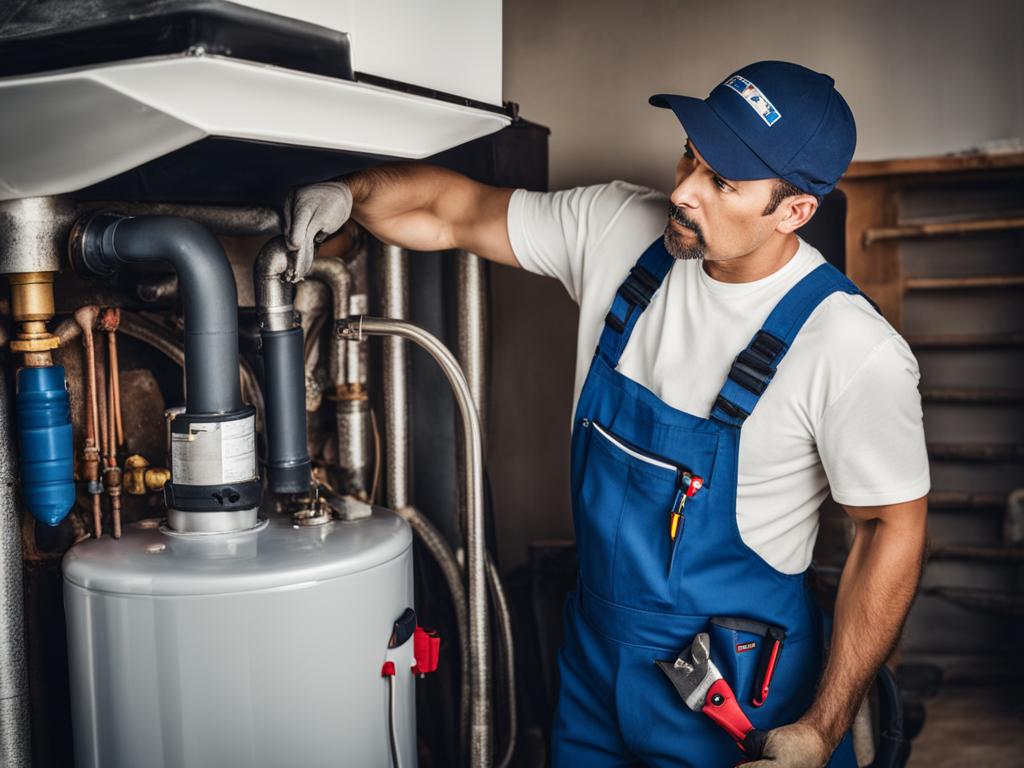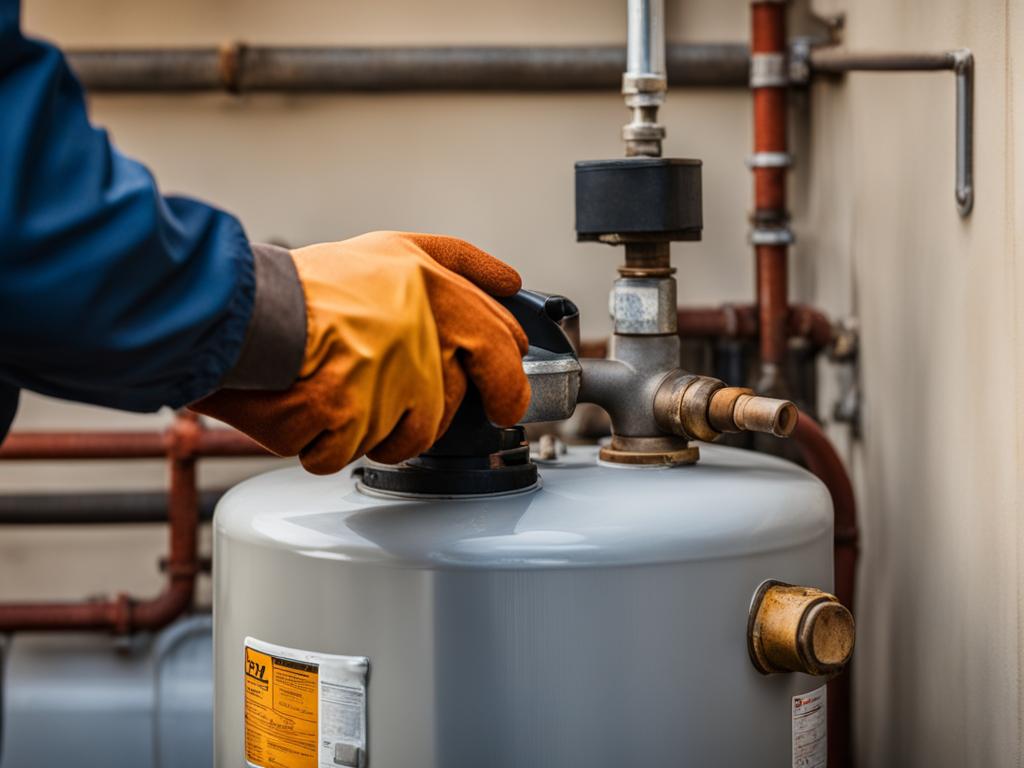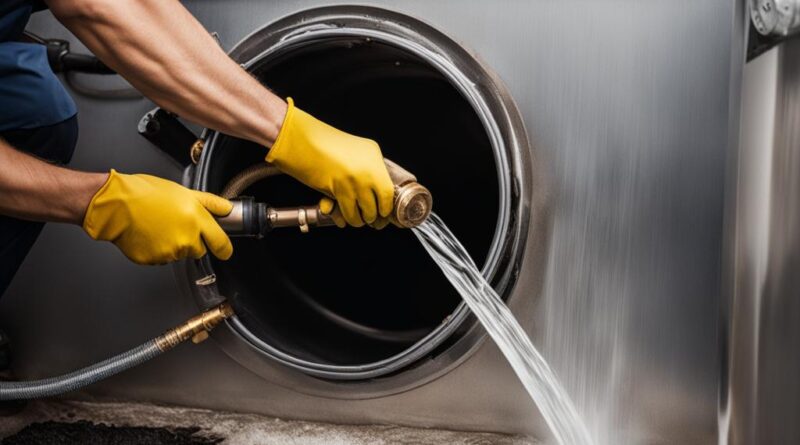How Long Does it Take to Drain a Water Heater? Get Insight Here!
Draining your water heater once a year is crucial to remove sediment buildup that can cause it to work harder and be less efficient. Sediment buildup is the leading cause of water heater failure and can result in energy wastage and the need for early replacement. Flushing the water heater annually can remove sediment from the bottom of the tank, improving the heater’s performance and prolonging its lifespan.
Key Takeaways:
- Draining your water heater annually helps remove sediment buildup and improves efficiency.
- Sediment buildup is the leading cause of water heater failure.
- Proper maintenance can extend the lifespan of your water heater.
- Flushing the tank annually removes sediment and enhances performance.
- Regular maintenance can save you money on repairs and replacements.
Why Should You Drain Your Water Heater Annually?
Regular maintenance is essential to ensure the optimal performance and longevity of your water heater. One crucial maintenance task is draining the water heater annually. By flushing out the sediment buildup in the tank, you can reap numerous benefits, including improved energy efficiency, cost savings, and a longer lifespan for your water heater.
Draining the water heater is especially important to remove sediment buildup. Over time, minerals and debris can accumulate at the bottom of the tank, causing the heater to work harder and consume more energy. By flushing out the sediment, you can enhance the efficiency of the water heater, which can result in significant cost savings on your energy bills over time.
Sediment buildup in water heaters can reduce their energy efficiency by up to 25%, leading to higher energy consumption and increased utility costs.
In addition to energy savings, regular maintenance such as draining the tank can extend the overall lifespan of your water heater. Sediment buildup not only affects energy efficiency but can also lead to corrosion and damage, eventually causing the water heater to fail prematurely. By removing the sediment, you can prevent potential issues and help your water heater last 15-20 years or even longer.
Table: Benefits of Annual Water Heater Draining
| Benefits | Description |
|---|---|
| Improved Energy Efficiency | Flushing out sediment buildup can enhance the water heater’s efficiency, resulting in cost savings on energy bills. |
| Extended Lifespan | Regular maintenance, including draining the tank, can help prevent corrosion and damage, prolonging the water heater’s lifespan. |
| Prevents Costly Repairs | By removing sediment and preventing damage, annual draining can help avoid expensive repairs or premature replacement of the water heater. |
Overall, draining your water heater annually is a critical maintenance task that can have long-term benefits for both your energy efficiency and the lifespan of your appliance. By taking proactive measures, such as regular maintenance and professional assistance when needed, you can ensure a consistent supply of hot water and maximize the performance of your water heater.
Steps to Drain Your Water Heater
Draining your water heater is an essential maintenance task that should be performed annually to ensure optimal performance and extend its lifespan. By following the proper steps, you can effectively remove sediment buildup and maintain energy efficiency. Here is a step-by-step guide on how to drain your water heater:
Step 1: Turn Off Gas or Electricity
Prior to draining the water heater, it’s important to turn off the gas or electricity supply. This is crucial to prevent any accidents or damage during the draining process.
Step 2: Close Cold Water Supply Valve
Locate the cold water supply valve, usually located near the top of the water heater, and close it. This will ensure that no more water enters the tank while you’re draining it.
Step 3: Attach Garden Hose
Next, attach a garden hose to the drain valve at the bottom of the water heater. Make sure the hose is securely connected to prevent any leaks or spills.
Step 4: Open Drain Valve and Release Pressure Relief Valve
Open the drain valve slowly to allow the water to flow out through the garden hose. Additionally, release the pressure relief valve on top of the water heater to allow air into the tank, facilitating smooth drainage.
Step 5: Flush Out Sediment
Allow the water to drain completely from the tank. You may notice sediment and debris being flushed out with the water. This step helps remove any buildup that may affect the performance of the water heater.
Step 6: Refill Tank and Turn Power Back On
Once the tank is empty, close the drain valve and remove the garden hose. Open the cold water supply valve to refill the tank, making sure to let the water flow until it runs clear. Finally, turn the gas or electricity supply back on to restore power to the water heater.
By following these steps and draining your water heater annually, you can effectively remove sediment buildup and ensure the optimal performance and longevity of your appliance.
Importance of Checking the Thermostat
One often overlooked aspect of water heater maintenance is checking the thermostat. The thermostat plays a crucial role in controlling the temperature of the water in the tank. It is essential to ensure that the thermostat is set at the optimal temperature to achieve the desired balance between energy efficiency and hot water production.
By setting the temperature correctly, you can maximize energy efficiency, which can result in significant cost savings over time. A water heater that is set too high not only consumes more energy but also increases the risk of scalding accidents. On the other hand, a thermostat set too low may not provide enough hot water for your needs.
Regularly checking and adjusting the thermostat can help maintain the right temperature for efficient operation. It is recommended to set the thermostat at 120°F or lower to strike a balance between energy savings and a reliable supply of hot water. This simple step can contribute to the overall energy efficiency of your water heater and ensure optimal performance.
Potential Benefits of Proper Thermostat Setting:
- Optimized energy efficiency
- Cost savings on energy bills
- Reduction in scalding risks
- Adequate hot water production
By paying attention to the thermostat setting, you can optimize your water heater’s energy efficiency, save money, and ensure a consistent supply of hot water for your daily needs.
Expert Tip:
Regularly check your water heater’s thermostat to ensure it is set at the recommended temperature for optimal energy efficiency and hot water production.
The Role of Sediment in Water Heaters
Sediment can significantly impact the performance and efficiency of water heaters. Over time, minerals and debris can accumulate at the bottom of the tank, forming sediment layers. This sediment buildup can lead to several problems, including reduced efficiency, potential damage, and the need for premature replacement.
One of the primary issues caused by sediment is reduced efficiency. As sediment settles at the bottom of the tank, it acts as an insulating layer, making it harder for the burner or heating element to transfer heat to the water. This insulating effect forces the water heater to work harder and longer to reach and maintain the desired temperature, resulting in increased energy consumption and higher utility bills.
In addition to reduced efficiency, sediment can also lead to potential damage. The accumulation of sediment can cause the bottom of the tank to overheat, leading to the deterioration of the tank itself. Over time, this can result in leaks or even complete tank failure, requiring costly repairs or replacement.
| Problems Caused by Sediment in Water Heaters |
|---|
| Reduced efficiency |
| Potential damage to the tank |
| Premature replacement |
Regular maintenance, such as annual draining and flushing, can help prevent sediment-related problems. By removing the accumulated sediment, water heaters can operate more efficiently, reduce the risk of damage, and potentially extend their lifespan. It is important to follow the manufacturer’s instructions or consult a professional plumber to ensure proper maintenance and to address any sediment-related issues promptly.
“Sediment accumulation in water heaters can have a detrimental effect on their efficiency and lifespan. Regular maintenance, including flushing the tank, is essential to prevent sediment-related problems and maximize the performance of your water heater.”
Troubleshooting Slow Water Heating
If your water heater is taking too long to heat the water, there are a few common causes to consider. Firstly, check the thermostat setting and ensure it is at the proper temperature. Sediment buildup in the tank can also slow down heating, so periodically flushing the water heater is crucial. Additionally, a clogged exhaust pipe can hinder proper ventilation and affect water heating. Troubleshooting these issues can help restore your water heater’s performance.
To troubleshoot slow water heating, follow these steps:
- Check the thermostat setting: Ensure that the thermostat is set to the desired temperature. If it is set too low, the water may take longer to heat up.
- Flush out sediment: Sediment buildup in the tank can reduce the efficiency of the water heater. Drain and flush the tank to remove any accumulated sediment.
- Inspect the exhaust pipe: A clogged or restricted exhaust pipe can affect the proper ventilation of the water heater. Make sure the exhaust pipe is clear of any obstructions.
By addressing these common issues, you can improve the performance of your water heater and enjoy faster hot water heating. However, if the problem persists or if you are unsure about performing these troubleshooting steps, it is recommended to seek professional assistance from a qualified plumber.

What to Do When Drain Valve Won’t Close
If you encounter a situation where the drain valve on your water heater won’t close after draining the tank, it is important to take appropriate action. There are several possible reasons why the valve may be malfunctioning, such as corrosion or a frozen valve. In such cases, seeking professional assistance is advisable to ensure the proper functioning of your water heater.
Corrosion can occur over time, causing the drain valve to become stuck or difficult to close. Attempting to force the valve closed can potentially cause further damage. It is best to consult a professional plumber who can assess the situation and determine the best course of action. They may recommend replacing the drain valve to restore the functionality of your water heater.
Another possibility is a frozen drain valve, especially in colder climates or during winter months. Freezing temperatures can cause water inside the valve to freeze, preventing it from closing properly. In this case, a plumber can apply the necessary measures to thaw the valve and ensure it closes correctly.
It is important to remember that attempting to fix the issue yourself without the proper knowledge and tools can lead to further damage or safety hazards. Consulting a professional plumber will provide you with expert advice and assistance to address the drain valve problem effectively.
Importance of Professional Plumbing Help
While water heater maintenance tasks can often be performed by homeowners, there are situations where professional plumbing assistance is crucial. Professional plumbers possess the necessary expertise and experience to handle complex water heater issues, ranging from valve replacements to repairs and troubleshooting.
Seeking professional help ensures that the job is done correctly, minimizing the risk of further damage or safety hazards. Plumbers have access to specialized tools and equipment, allowing them to diagnose and address problems efficiently. They can also provide valuable advice on preventive measures and maintenance techniques to optimize the performance and longevity of your water heater.
When faced with significant issues or uncertainties, it is always best to consult a professional plumber. Their expertise can save you time, money, and the frustration of attempting complex repairs or replacements on your own. By entrusting your water heater maintenance to professionals, you can have peace of mind knowing that your system is in capable hands.

Benefits of Professional Plumbing Help:
- Expertise and experience in handling complex water heater issues
- Access to specialized tools and equipment
- Efficient diagnosis and resolution of problems
- Guidance on preventive measures and maintenance techniques
- Time and cost savings
- Peace of mind knowing the job is done correctly
Benefits of Warranty for Water Heaters
When purchasing a water heater, it is important to consider the benefits of having a warranty. A water heater warranty provides valuable financial protection, offering repair coverage and even replacement coverage for certain issues that may arise with your appliance.
With a warranty, you can have peace of mind knowing that if your water heater develops any unexpected problems, you won’t have to bear the full cost of repairs or replacement. This can save you a significant amount of money and prevent unforeseen expenses.
A water heater warranty typically covers common issues such as leaks, faulty valves, malfunctions in heating elements, and tank failure. By having a warranty in place, you can rest assured that you will receive timely assistance and support in case of any malfunctions or failures.
| Benefits of Water Heater Warranty |
|---|
| Financial Protection |
| Repair Coverage |
| Replacement Coverage |
When choosing a water heater warranty, it is essential to review the terms and conditions to understand what is covered and for how long. Some warranties may have specific requirements, such as regular maintenance or professional installation, to ensure that the warranty remains valid.

Signs Indicating the Need for Water Heater Replacement
Over time, water heaters can deteriorate and experience various issues that may require replacement. It’s essential to recognize the signs indicating that your water heater may need to be replaced to avoid further problems and ensure a reliable supply of hot water. The following are some common signs that it may be time for a water heater replacement:
- Inadequate hot water supply: If your water heater is no longer providing enough hot water for your needs, it may be a sign of a failing unit. This can be caused by a variety of factors, such as a worn-out heating element or a malfunctioning thermostat.
- Frequent breakdowns or repairs: If you find yourself constantly dealing with water heater issues and calling for repairs, it may indicate that your unit is reaching the end of its lifespan. As water heaters age, they become more prone to breakdowns and failures.
- Age of the water heater: The average lifespan of a water heater is around 10-15 years. If your unit is approaching or exceeding this age range, it’s a good idea to consider a replacement. Older water heaters are less energy-efficient and more likely to develop problems.
Identifying these signs early on can help you make an informed decision about whether to replace your water heater. Consulting with a plumbing professional can provide further guidance and help you explore suitable options for your specific needs.
Table: Signs Indicating the Need for Water Heater Replacement
| Signs | Description |
|---|---|
| Inadequate hot water supply | Your water heater no longer provides enough hot water for your needs. |
| Frequent breakdowns or repairs | You experience frequent issues with your water heater, requiring frequent repairs. |
| Age of the water heater | Your water heater is nearing or exceeding its average lifespan of 10-15 years. |
If you notice any of these signs, it’s advisable to consider replacing your water heater to ensure efficient and reliable hot water supply in your home. Replacing an aging or failing water heater can save you from the inconvenience of unexpected breakdowns and help you avoid costly repairs in the long run.
The Importance of Regular Maintenance for Water Heaters
Regular maintenance is essential for water heaters to ensure optimal performance, longevity, and cost savings. By implementing preventive measures and attending to maintenance tasks, you can prolong the lifespan of your water heater and prevent potential issues that may arise.
One of the key maintenance tasks for water heaters is draining and flushing the tank annually. This process helps remove sediment buildup that can accumulate at the bottom of the tank over time. Sediment buildup can affect the efficiency of the heater, resulting in higher energy consumption and reduced performance. By flushing out the sediment, you can restore optimal performance and improve energy efficiency, leading to cost savings on your energy bills.
“Regular maintenance is crucial for water heaters to ensure optimal performance and longevity.”
In addition to draining and flushing, it is important to check the thermostat regularly. Setting the thermostat at the recommended temperature of 120°F or lower can help optimize energy efficiency and prevent scalding accidents. This ensures that your water heater produces hot water at the desired temperature while minimizing energy wastage.
Maintaining a regular maintenance schedule for your water heater can also help identify and address potential issues early on. By inspecting for leaks, checking for signs of deterioration, and attending to any problems promptly, you can prevent more significant issues from occurring. This proactive approach can save you money on repairs and replacements in the long run.
| BENEFITS OF REGULAR WATER HEATER MAINTENANCE |
|---|
| 1. Optimal performance |
| 2. Improved energy efficiency |
| 3. Cost savings on energy bills |
| 4. Prolonged lifespan of the water heater |
| 5. Early detection and prevention of issues |
By prioritizing regular maintenance for your water heater, you can ensure a reliable supply of hot water and maximize the lifespan of your appliance. Whether it’s draining and flushing the tank, checking the thermostat, or addressing any potential issues, investing in maintenance measures will pay off in the long run.

Conclusion
Regular maintenance is crucial for the optimal performance and extended lifespan of your water heater. Draining your water heater annually is a vital maintenance task that helps remove sediment buildup and ensures energy efficiency.
By prioritizing water heater maintenance, you can prevent costly repairs or replacements. It’s important to note that while some maintenance tasks can be done by homeowners, seeking professional assistance may be necessary for complex issues or valve replacements.
By investing in proper maintenance, you can ensure a consistent supply of hot water, maximize the lifespan of your water heater, and improve energy efficiency. Take care of your water heater by scheduling regular drainage and maintenance, and consider consulting a professional for any significant issues.
FAQ
How long does it take to drain a water heater?
The time it takes to drain a water heater can vary depending on several factors, such as the size of the tank and the sediment buildup. On average, it can take around 30 minutes to an hour to fully drain a water heater.
Why should you drain your water heater annually?
Draining your water heater annually is important to remove sediment buildup, improve energy efficiency, and extend the lifespan of your water heater.
What are the steps to drain your water heater?
The steps to drain a water heater include turning off the gas or electricity, closing the cold water supply valve, attaching a garden hose, opening the drain valve, releasing the pressure relief valve, flushing out sediment, refilling the tank, and turning the power back on.
How does checking the thermostat contribute to water heater maintenance?
Checking the thermostat allows you to ensure that it is set at the proper temperature, optimizing energy efficiency and preventing scalding accidents. It also ensures adequate hot water production for your needs.
What role does sediment play in water heaters?
Sediment can accumulate in the bottom of a water heater tank over time and cause reduced energy efficiency, decreased hot water production, and potential damage to the heating elements. Flushing the tank annually helps prevent sediment-related problems.
What are some common causes of slow water heating in a water heater?
Slow water heating can be caused by a thermostat not set at the correct temperature, sediment buildup in the tank, or a clogged exhaust pipe hindering proper ventilation. Troubleshooting these issues can help restore the water heater’s performance.
What should I do if the drain valve on my water heater won’t close?
If the drain valve on your water heater won’t close, it may be due to corrosion or other issues. It is advisable to seek professional assistance to replace the drain valve and restore proper functioning.
Why is professional plumbing help important for water heater maintenance?
Professional plumbers have the expertise and experience to handle complex water heater issues, such as valve replacements, repairs, and troubleshooting. If you are unsure or encountering significant problems, consulting a professional is recommended to avoid potential damage or safety hazards.
What are the benefits of having a warranty for your water heater?
Having a warranty for your water heater provides valuable financial protection. It typically covers repair or replacement costs for certain issues, giving you peace of mind and protecting your budget from unexpected expenses.
What are the signs that it may be time to replace a water heater?
Signs that it may be time to replace your water heater include inadequate hot water supply, frequent breakdowns or repairs, and the age of the water heater. Consulting with a plumbing professional can help determine if a replacement is necessary and explore suitable options.
Why is regular maintenance important for water heaters?
Regular maintenance is crucial for water heaters to ensure optimal performance and longevity. It helps remove sediment buildup, prevent costly repairs or replacements, and ensures a reliable supply of hot water.

